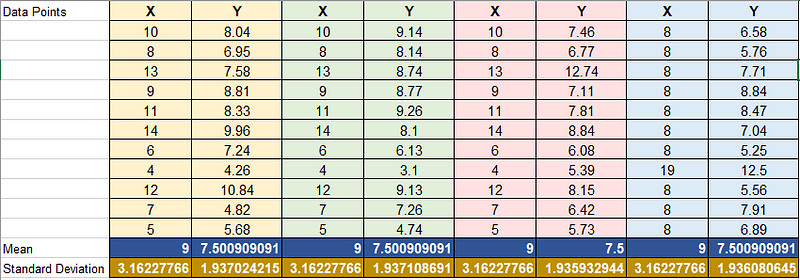Unlocking Insights Through Data Visualization Techniques
Written on
The Importance of Data Visualization
In today's world, vast amounts of raw data are generated every minute—over 90% of which has emerged in just the past decade. As a result, individuals and organizations are increasingly focused on making sense of this information. A critical component of this understanding is data visualization.
Why is visualization essential when we have numerous mathematical formulas at our disposal? The answer becomes clearer with an illustrative example.

Consider four distinct datasets represented by X and Y coordinates, each accompanied by their respective means and standard deviations. Notably, these datasets exhibit identical statistical measures. However, does this similarity suggest that they follow the same trend? To uncover the truth, we can visualize this data in a two-dimensional graph. For a deeper exploration of these datasets, refer to the link below the images.

The ensuing graph illustrates the points from the four datasets plotted on a two-dimensional axis.
Understanding Anscombe's Quartet
Anscombe's quartet consists of four datasets that share nearly identical descriptive statistics, yet they reveal vastly different distributions and correlations.
For further reading, visit:
The Advantages of Data Visualization
Before diving deeper into the specifics of data visualization and its numerous benefits, let's pause to view a video that exemplifies effective data presentation. In this clip, Hans Rosling demonstrates the health and wealth of 200 countries over the span of 200 years.
Take a moment to appreciate the sheer volume of data conveyed in this brief four-minute presentation, which covers multiple dimensions in a concise graphical format.
There are compelling reasons why visual information is processed more quickly by our brains compared to text. Visualization caters to our innate human preference for visual data, as our brains can interpret images approximately 60,000 times faster than words. Remarkably, around 90% of the information our brains receive is visual. This inherent predisposition enables us to utilize visualization to enhance data comprehension and improve organizational efficacy.
Organizations often grapple with highly intricate data that encompasses multidimensional relationships across extensive datasets—ranging from sales figures to demographic insights, geographic locations, and promotional activities. The positive aspect is that this data is inherently geospatial and can be effectively visualized. By breaking down data silos across departments, organizations can facilitate quicker and more accurate decision-making. Furthermore, visual data fosters collaboration and sparks innovative ideas that can significantly enhance performance.
As Harris Eisenberg, Executive Vice President, aptly puts it, "Human beings are visual creatures. The time has come for organizations to adopt advanced data visualization strategies to unlock their true potential in achieving their objectives."
Reflecting on Hans Rosling’s presentation, one can observe that the accompanying research paper, which contained 18 graphs and over 2,000 words, could hardly compete with the clarity and impact of the visual presentation. Wouldn't it be more effective to comprehend the data through such a visual medium rather than sifting through pages of dense text?